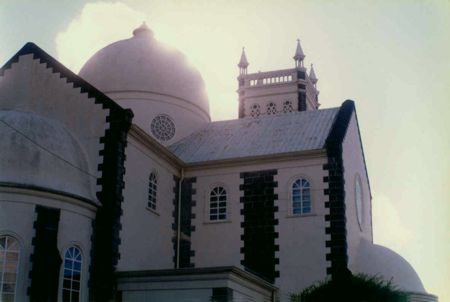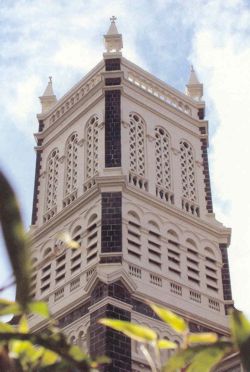|
Embargo until 8 September 2006 Revisiting Father Laval (1803-1864)
|
||
|
Jacques Désiré Laval was born on 18 September 1803 in Croth, Normandy, France. Son of a prosperous farmer, Jacques grew up in a pious household with examples set by his mother and an uncle who was a priest. Jacques' mother died when he was seven years old. Jacques was educated at local schools, Evraux, and Stanlislaus College in Paris, and received his medical degree in 1830. However, a near fatal fall from a horse led him to re-examine his life. In 1835, he entered the seminary of Saint Sulpice and was ordained four years later. He came in Mauritius in 1841 and during a mass on 26 th September of the same year, it was announced that Father Laval would start ‘ La Mission des Noirs’. Jacques lived with the Blacks, learned their language (kreol), fasted when supplies were short, slept in a packing crate, used his medical training to heal them, and explained that to God there were no unimportant people. He had a team of close collaborators called Les Auxiliaires, who were mainly male and female ex-slaves. It can be said that they were the first Catholic communities and founders of the Mauritian church. Father Laval died on 9 September 1864 at 13.40. Some 40,000 people attended his funeral. Today revisiting the life and achievements of Father Laval can help to throw light on the challenges facing the Catholic Church of Mauritius. La question créoleIf Father Laval life was all dedicated to the upliftment of the ex-slaves, one of the main challenges facing the Church today is indubitably la question créole. Things have evolved rapidly ever since Father Roger Cerveaux set the ball rolling when he talked outspokenly in the press (Week-End, 1989) of the ‘malaise créole’. He referred to the profound uneasiness felt by the kreols with regard to the place they are given to occupy in the Church. Notwithstanding the highly debated issue of the position of the kreol community in the Church and the legitimacy of the kreol priests who claim both their creolity (cultural identity) and catholicity (universality) in Jesus Christ, it is interesting to note that notable strides have been made by the Church during these past ten years: Bishop Mgr Piat was the first to recognise the fait créole (Oct, 1993); recognition of the contribution of the desandan esklav in the church and the country during the annual mass celebration of the Abolition of Slavery at Vieux Grand Port ( 2006) ; ecumenical current translation of the Gospels in kreol Morisyin; Father Jocelyn Gregoire’s mass evangelisation sessions which have regular snowball effects. Today, the kreol issue is no longer in its vindication phase within the Church. Interestingly enough, it is giving a new profiling to the Mauritian church. The Etude des comportements religieux en monde populaire créole (1995), recent anthropological and theological research work made by contemporary academics of the Mauritian Church (Karl Lauricourt, Alain Romaine, Dr Danielle Palmyre-Florigny) and the demise publications of Marye-Pike (2002-2004) have enriched the local Church literature and enhance considerably our comprehension of the mores and ethos of the kreol catholics. There is a growing awareness that the Church teachings need the complementary world of the kreols. It is the encounter of the Gospel with the kreol culture. This new dimension in the pastoral mission of the church is unlocking the untapped potentialities of this community. In fact, what might have been in its infancy an identity or ethnic problem, laquestion kreol may lead the whole Church to explore the contours of a true Mauritian Catholic spirituality and theology. This will eventually be beneficial to other cultures within the Church. A parallel can be drawn here to the positive impact of the early work of Father Laval upon the Whites. In fact, for L. Verchère (2003), it is paradoxically the female ex-slaves who were baptized by Father Laval who turned out to be the first “domestiques missionaires de leurs maitres”. Father Laval’s achievements amongst the Blacks moved the Whites. They were amazed at the piety of the Blacks who have known him. They wanted a priest akin to Father Laval who could look after their religious instruction. In 1845 Mgr Collier came back from Europe with three priests. Amongst whom was Abbey Masuy from Belgium. The latter carried out his missionary work amongst the Whites. Intercultural dialogueFor Crittenden ( 2001) , religion is about a whole lot more than going to church. It is about our collective imaginings, about what they tell us about ourselves, and how they bind us together. A mediation of divine immanence begins with a sense of place; of one’s being of some particular place or places, as a being –of-the earth. To be of a place is not merely being in a place. One can live in Mauritius and not ‘put down roots’. Mauritian Catholic spirituality would be the experience of faith in Jesus Christ given in the land culture where we have put down roots. Certainly, by virtue of its universality the Catholic Church cannot get entrenched into a kreol ethno-centrism. It has to get into dialogue with other cultures within and outside. According to J.C. Veder (2004), multiculturalism does not foster a common or shared enchantment, because its ethic is based on mutual tolerance of those who remain other and outside our own experience. The multicultural system is modelled on tolerance, not creative integration or engagement. Our current ethic seems to say that if you do not bother me, I will not bother you and that is how we get along in Mauritius and in the local Church. Creative dialogue or inter-culturalité as an alternative to multiculturalism is about risk and cross-fertilisation producing ever-new hybrids and unities. How far will the Catholics be able to engage into an inter-cultural dialogue within the Church comprising Catholics of different cultures, social background and ethnic origins? Reintegrating the laityAnother challenge facing the Catholics is the role of the laity in a future Church. With the scarcity of priests, the Church is devolving further responsibilities to lay Catholics. The Church has honoured the contributions of the collaborators of Father Laval and their loving memory. Their names are displayed on a board in the Church of Roche Bois. But the role of the lay Catholics will not be limited to giving a helping hand to monper. The Church is currently debating on the place of the laity in a modern context. In the Bible we learn that in Jewish worship, only the priests had access to God. They alone could enter the temple and mediate between the God who was holy and the profane people outside. But all baptized Christians do have access through Christ to God and to grace, for baptism is a share in His life (cf.Romans6:1-11; Hebrews 10:22). How will a future Mauritian church help its members who will be in a position of responsibility and leadership access the teachings and approaches to prayer and doctrines, to prophetic witness to social justice, to the heroines and heroes who teach us about the love of Christ? The church invests a lot in training. But how far have the trainings been effective and beneficial to the community? The missionary zeal of Father Laval, the courage of Mère Marie Magdeleine de La Croix in Reunion Island after the abolition of slavery in 1848, the radical poverty of Francis of Assisi and the commitment of Mary Ward to education can inspire future lay Catholics leaders. ‘Secular’ Mauritian heroes like Dr Maurice Curé, Emmanuel Anquetil, Marcel Cabon or the Bissoondoyal Brothers for their passion for justice remind us that God’s compassionate love is also exemplified without religious affiliations. Hence, this is certainly consonant to the theme Avek Per Laval viv levanzil o servis nou pei. Jimmy Harmon
REFERENCESBernier, P (1992), Ministry in the church: A historical and pastoral approach.( ACU) Crittenden, S (2001), Highly Spirited. (ACU) Dreyer, E, (1994), The Worldly face of God: A spirituality of everyday life.(ACU). Veder,J.C (2004). Dire Dieu jusqu’à le célebrer.Ed.Marye Pike. Verchère, L ( 2003) Vive lumière sur les iles: Le bienheureux Père Laval.Ed.Centre Père Laval.
|
||
| |
||
|
|


